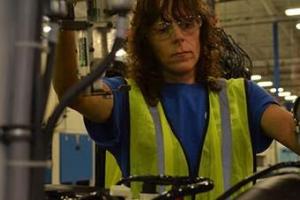Household Debt: How the Bottom Half Bolsters the Booming U.S. Economy
Reuters
 Much attention has been given in recent years to low-wage work in the fast-food industry, big-box retail, and other service sector industries in the U.S. The rise of low-wage business models in the service sector has often been contrasted to business models of the past, when blue collar jobs in the manufacturing industry supported a large middle class in the U.S. Recent research found that manufacturing production wages now rank in the bottom half of all jobs in the U.S.
Much attention has been given in recent years to low-wage work in the fast-food industry, big-box retail, and other service sector industries in the U.S. The rise of low-wage business models in the service sector has often been contrasted to business models of the past, when blue collar jobs in the manufacturing industry supported a large middle class in the U.S. Recent research found that manufacturing production wages now rank in the bottom half of all jobs in the U.S.
 Washington raised the minimum wage in 1998 linking it to inflation. In the 15 years that followed, the state's minimum wage climbed to $9.32 - highest in the country. Meanwhile job growth continued at an average 0.8 percent annual pace, 0.3 percentage point above the national rate. Payrolls at Washington's restaurants and bars, portrayed as particularly vulnerable to higher wage costs, expanded by 21 percent.
Poverty has trailed the U.S. level for at least seven years
Washington raised the minimum wage in 1998 linking it to inflation. In the 15 years that followed, the state's minimum wage climbed to $9.32 - highest in the country. Meanwhile job growth continued at an average 0.8 percent annual pace, 0.3 percentage point above the national rate. Payrolls at Washington's restaurants and bars, portrayed as particularly vulnerable to higher wage costs, expanded by 21 percent.
Poverty has trailed the U.S. level for at least seven years
Spread the word